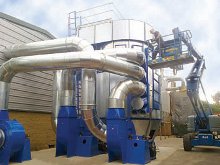Dust busting
23 February 2013The HSE has expanded its advice on wood dust to help companies ensure they’re getting the most from their LEV systems. Keren Fallwell reports
The Health & Safety Executive (HSE) has updated and expanded its information on wood dust.
WIS23(rev1) Wood dust: Controlling the risks contains new information on the use of airflow indicators and dust lamps as well as advice on how to improve dust control on circular saws.
It replaces the earlier version of WIS23 as well as WIS24 LEV: Dust capture at sawing machines, WIS25 LEV: Dust capture at fixed belt sanding machines, WIS26 LEV: Dust capture at fixed drum and disc sanding machines and WIS1(rev1) Wood dust: Hazards and precautions.
The new advice also covers hood design - one of the most common problems with LEV systems, said Cliff Seymour, HSE inspector, general manufacturing section - wood and rubber.
"WIS 23 suggests improvements that can be made to hoods, such as the simple addition of a spigot to the LEV connection of a circular saw's crown guard. This will then help remove the dusty air from the guard/hood more efficiently."
The new information on airflow indicators has been added as they give a continuous and clear indication that the LEV system is working correctly. "For example," said Mr Seymour, "they will immediately show if there is a blockage or if a damper hasn't been adjusted correctly."
An LEV system should be simple and robust in design so it requires minimum maintenance.
However, it must also be effective and an easy way to check its efficiency is either a dust lamp or a smoke generator.
"Dust lamps are a cheap and easy way to see if there is a problem," said Mr Seymour.
Airborne wood dust is normally invisible to the naked eye but by lowering the background lighting and shining a lamp on a particular area dust particles can be identified.
"Although many woodworking companies have an LEV system it may not have been designed or set up to be working as well as it could," said Mr Seymour. "WIS23 gives examples of what should be taken into consideration to get the most effective and efficient LEV system."
As well as capturing the fine wood dust, the extraction system should remove the larger/heavier chips and shavings.
The HSE says the woodworking industry is unusual in that often the LEV extracts from different combinations of machines at different times. Having one system for various machines means it should be designed to accommodate the maximum number of machines that will be used at any one time. "You therefore need to know the maximum number of hoods that the fan can extract from and still control the dust," the HSE says.
"Displaying a plan in the workplace that shows which combinations of hoods can be open will help to manage the use of the system so the number is not exceeded."
"It is important that employers work closely with LEV designers to make sure that their system will do the job they expect," said Mr Seymour. "The designer should be able to prove that the LEV system works and is controlling the dust when the LEV system is commissioned. Employers should also make sure the system is well maintained and used correctly by operators so that it continues to work efficiently."
A well-designed system will not only control dust, it will be more energy efficient too, the HSE says.
